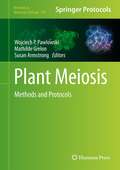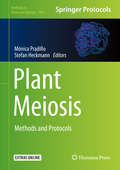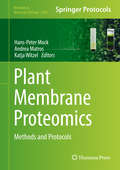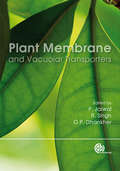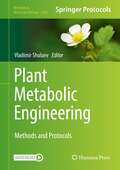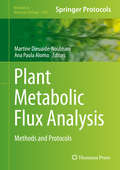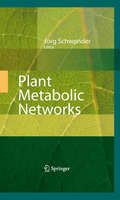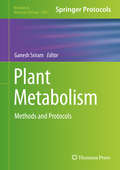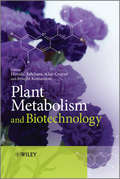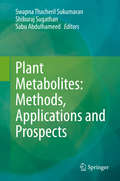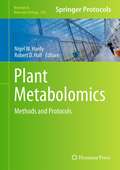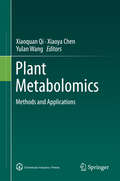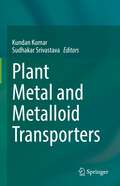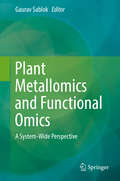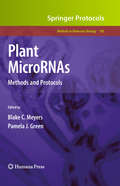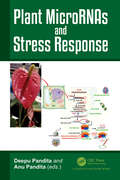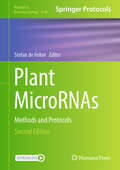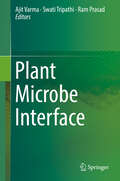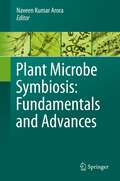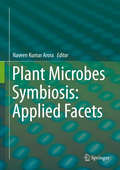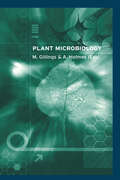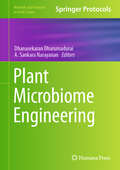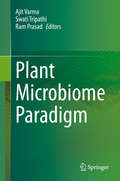- Table View
- List View
Plant Meiosis
by Wojciech P. Pawlowski Susan Armstrong Mathilde GrelonMeiosis is one of the most critical processes in eukaryotes, required for continuation of species and generation of new variation. In plants, meiotic recombination is by far the most important source of genetic variation. In Plant Meiosis: Methods and Protocols, expert researchers in the field detail methods for molecular cytogenetics and chromosome analysis in plants. These state-of -the-art protocols allow studying the organization and behavior of the genetic material in a wide range of both model and crop species. Written in the highly successful Methods in Molecular BiologyTMseries format, chapters include introductions to their respective topics, lists of the necessary materials and reagents, step-by-step and readily reproducible laboratory protocols, and key tips on troubleshooting and avoiding known pitfalls. Authoritative and practical, Plant Meiosis: Methods and Protocols provides and extensive list of protocols developed and used in a number of laboratories at the cutting edge of meiosis and chromosome research.
Plant Meiosis: Methods and Protocols (Methods in Molecular Biology #2061)
by Mónica Pradillo Stefan HeckmannThis volume looks at the latest techniques used by the meiosis research community to study plant meiosis. The chapters in this book are organized into four parts: Part One discusses cytological and imaging approaches to study meiosis and chromosome dynamics in Arabidopsis (in both diploid and polyploid backgrounds); Part Two talks about using cytological methods to study meiosis in other plant species; Part Three focuses on molecular and biochemical approaches to look at plant meiosis; and Part Four explores further procedures and experiments that are helpful in learning more about plant meiosis. Written in the highly successful Methods in Molecular Biology series format, chapters include introductions to their respective topics, lists of the necessary materials and reagents, step-by-step, readily reproducible laboratory protocols, and tips on troubleshooting and avoiding known pitfalls.Thorough and cutting-edge, Plant Meiosis: Methods and Protocols is a valuable resource for both novice and expert researchers who are interested in learning more about this developing field.
Plant Membrane Proteomics
by Hans-Peter Mock Andrea Matros Katja WitzelThis volume provides comprehensive and detailed protocols that discuss proteomic techniques, plant endosomes, and isolation of organelles and subcellular fractions. The chapters in this book explore numerous plant species and cover topics, such as isolation and purity assessment of membranes from Norway spruce; proteomic analysis of nuclei; analyzing the vacuolar membrane (tonoplast) proteome; isoforms of a thylakoid-bound protein; assay of plasma membrane H+-ATPase in plant tissue under abiotic stresses; and identification and characterization of plant membrane proteins using ARAMEMNON. Written in the highly successful Methods in Molecular Biology series format, chapters include introductions to their respective topics, lists of the necessary materials and reagents, step-by-step, readily reproducible laboratory protocols, and tips on troubleshooting and avoiding known pitfalls. Practical and thorough, Plant Membrane Proteomics: Methods and Protocols is a valuable resource that promotes the use of plant membrane proteomics to develop the future of the field.
Plant Membrane and Vacuolar Transporters
by Om Parkash Dhankher Rana P. Singh Pawan K. JaiwalBased on current research in genomics and proteomics, this book clarifies the identification and characterization of plant membrane and vacuolar transporters.
Plant Metabolic Engineering: Methods and Protocols (Methods in Molecular Biology #2396)
by Vladimir ShulaevThis volume looks at the latest techniques used by researchers to study various aspects of plant metabolic engineering. The chapters in this book cover topics such as bioinformatics tools used to discover new genes and pathways; heterologous expression of biosynthetic genes in plant and microbial systems; and omics technologies, such as transcriptomics, proteomics, metabolomics, and data analysis. Written in the highly successful Methods in Molecular Biology series format, chapters include introductions to their respective topics, lists of the necessary materials and reagents, step-by-step, readily reproducible laboratory protocols, and tips on troubleshooting and avoiding known pitfalls. Cutting-edge and comprehensive, Plant Metabolic Engineering: Methods and Protocols is a valuable resource for biologists, chemists, biotechnologists, students, and broad cohorts of researchers who works in the fields of plant metabolism and metabolic engineering.
Plant Metabolic Flux Analysis
by Martine Dieuaide-Noubhani Ana Paula AlonsoIn "Plant Metabolic Flux Analysis," expert researchers in the field provide detailed experimental procedures for each step of the flux quantification workflow. Steady state and dynamic modeling are considered, as well as recent developments for the reconstruction of metabolic networks and for a predictive modeling. Written in the highly successful "Methods in Molecular Biology "series format, chapters include introductions to their respective topics, lists of the necessary materials and reagents, step-by-step, readily reproducible laboratory protocols and key tips on troubleshooting and avoiding known pitfalls. Authoritative and practical" Plant Metabolic Flux Analysis," seeks to aid scientists in the further study of cutting-edge protocols and methodologies that are crucial to getting ahead in MFA.
Plant Metabolic Networks
by Jacqueline V. Shanks Jörg SchwenderPlants are the basis for human nutrition and of increasing interest for the chemical industry as a source of chemical feed stocks. Fuels derived from plant biomass will increasingly replace fossil fuels in the future. In order to increase crop productivity, design new plant products, and create new energy crops, there is need for methods of qualitative and quantitative analysis of metabolism which are able to guide the rational re-design of metabolic networks. In this book, recent advances in qualitative and quantitative analysis of metabolism are summarized to give an overview of the current state of knowledge. Principles of the analysis of network structure, flux analysis, and kinetic modeling are described. Analytical methods necessary to produce the data needed for metabolic flux analysis and for kinetic modeling are described. The analysis of larger metabolic networks is only possible by using computer assistance. Therefore each chapter of the book shall also describe software available for this purpose.
Plant Metabolism
by Ganesh SriramIn Plant Metabolism: Methods and Protocols, expert researchers in the field present the latest methods on quantitative analysis of plant metabolism. The methods focus on measurements, analyses and simulations of molecules, fluxes, and ultimately entire metabolic pathways and networks. Written in the highly successful Methods in Molecular Biology series format, chapters include introductions to their respective topics, lists of the necessary materials, reagents, or software, step-by-step, readily reproducible laboratory protocols, and key tips on troubleshooting and avoiding known pitfalls. Authoritative and practical, Plant Metabolism: Methods and Protocols seeks to benefit scientists ranging from plant biology, metabolic engineering, and biotechnology.
Plant Metabolism and Biotechnology
by Atsushi Komamine Alan Crozier Hiroshi AshiharaVarious plant metabolites are useful for human life, and the induction and reduction of these metabolites using modern biotechnical technique is of enormous potential important especially in the fields of agriculture and health. Plant Metabolism and Biotechnology describes the biosynthetic pathways of plant metabolites, their function in plants, and some applications for biotechnology. Topics covered include: biosynthesis and metabolism of starch and sugarslipid biosynthesissymbiotic nitrogen fixationsulfur metabolismnucleotide metabolismpurine alkaloid metabolismnicotine biosynthesisterpenoid biosynthesisbenzylisoquinoline alkaloid biosynthesismonoterpenoid indole alkaloid biosynthesisflavonoid biosynthesispigment biosynthesis: anthocyanins, betacyanins and carotenoidsmetabolomics in biotechnologyPlant Metabolism and Biotechnology is an essential guide to this important field for researchers and students of biochemistry, plant biology, metabolic engineering, biotechnology, food science, agriculture, and medicine.
Plant Metabolites: Methods, Applications and Prospects
by Sabu Abdulhameed Shiburaj Sugathan Swapna Thacheril SukumaranFood security and the medicinal needs of billions of people around the world are pressing global issues, and the biodiversity and sustainable utilization of plants is of great significance in this context. Further, ethnobotanical studies are vital in the discovery of new drugs from indigenous medicinal plants, and plants with industrially important metabolites need to be cultivated to meet the growing market demand. In addition, the production of plant metabolites under in vitro conditions also has tremendous possibilities. The totipotency of plant cells plays a valuable role in the sustainable utilization of plant resources through cell, tissue and organ culture. At the same time, production can be enhanced using productive cell lines, treatment with elicitors, changing nutritional parameters and metabolic engineering. This book provides state-of-the-art information on biodiversity, conservation, ethnobotany, various aspects of In vitro secondary metabolite production, bioprospecting from various plant groups and drug discovery. It also discusses methods of extracting and characterizing drug leads from plant sources.
Plant Metabolomics
by Robert D. Hall Nigel W. HardyEstimation of the metabolite complement of plant material involves a wide range of techniques and technologies and that breadth continues to increase. Metabolomics research typically involves multiple sites for material preparation and analysis and most investigations are "high throughput", meaning that chemical analysis of sample sets are inevitably carried out over an extended period of time. In, Plant Metabolomics: Methods and Protocols expert researchers in the field detail many of the stages which are now commonly used to study plant metabolomics workflow. Stages of this workflow, up to and including the statistical analysis, accurate and detailed collection of meta-data are also essential for good process management, to satisfy reporting requirements and to ensure wider interpretability and reuse results.Written in the highly successful Methods in Molecular BiologyTM series format, chapters include introductions to their respective topics, lists of the necessary materials and reagents, step-by-step, readily reproducible laboratory protocols, and key tips on troubleshooting and avoiding known pitfalls. Through and intuitive Plant Metabolomics: Methods and Protocols, seeks to aid scientists in the further study of the methods for all the stages of the plant metabolomics workflow.
Plant Metabolomics
by Xiaoquan Qi Xiaoya Chen Yulan WangThis book introduces plant metabolomics, an experimental approach that is important in both functional genomics and systems biology. It can be argued that metabolite data is most closely linked to phenotypes and that changes in metabolite content or metabolic networks can therefore indicate gene function more directly than mRNA transcript or protein based-approaches. Additionally, the identification of metabolic markers has important applications in plant breeding. The book, written by researchers who are active in plant metabolomics in China, not only introduces the fundamental concepts and the latest methodological advances in the field of plant metabolomics, but also details new studies from the respective scientific programs of the authors and thus reflects the current state of domestic plant metabolomics research. Professor Xiaoquan Qi is the principal investigator at the Institute of Botany, CAS. Professor Xiaoya Chen is a member of the Chinese Academy of Science and also is the principal investigator at the Shanghai Institutes for Biological Sciences, CAS. Professor Yulan Wang is leading a team in BioSpectroscopy and Metabolomics at the Wuhan Institute of Physics and Mathematics, CAS.
Plant Metabolomics: Methods and Protocols (Methods in Molecular Biology #1778)
by Carla AntónioThis detailed book aims to address the need for standardizing key steps in plant metabolomics research that is still considered a critical issue in the field. The collection unites diverse mass spectrometry (MS)-based protocols, from sample preparation and extraction of plant primary and secondary metabolites (e.g. a range of sugars, lipids, phytohormones and volatile organic compounds) to metabolite analysis, using exclusively highly sensitive MS-based methodologies, followed by frontline bioinformatics and/or mathematical modeling approaches to produce reliable biological data interpretation. Written for the highly successful Methods in Molecular Biology series, chapters include introductions to their respective topics, lists of the necessary materials and reagents, step-by-step, readily reproducible laboratory protocols, and tips on troubleshooting and avoiding known pitfalls. Authoritative and practical, Plant Metabolomics: Methods and Protocols serves both new and well-established researchers in the plant metabolomics field in finding helpful guidelines and useful laboratory-based protocols for setting up their routine plant metabolomics experiments.
Plant Metal and Metalloid Transporters
by Kundan Kumar Sudhakar SrivastavaThis edited book stands as a one place knowledge hub for plant metal(loid) transporters. The book comprehensively covers holistic aspect of metal(loid) transporters involved in uptake and translocation of essential as well as toxic metal(loid)s. Essential and beneficial metal(loid)s are required in every biological process for normal plant growth and development, however in excess they are toxic. There are toxic metal(loid)s also whose accumulation in plants interferes with normal cellular functioning and hampers growth of plants. Hence, metal(loid) uptake and accumulation in plants is a highly regulated phenomenon involving the role of several transporters, enzymes, metabolites, transcription factors and post translational modifications. The book contains chapters from the experts and the contents of the book are presented in simple language and represented through beautiful and scientifically informative figures and tables. This book is of interest to teachers, researchers, doctoral and graduate students working in the area of plant physiology, environmental biotechnology, plant biotechnology metal(loid) stress, phytoremediation and crop biofortification.
Plant Metallomics and Functional Omics: A System-Wide Perspective
by Gaurav SablokMajor portion of the planet earth is covered by seas and oceans representing 96.5% of the planet’s water, playing a detrimental role in sustaining the plant including crop diversity and productivity for human consumption. Water resources contain both soluble and transition metals, which are easily absorbed by plants through roots as a first point of contact and subsequently play important physiological and biological functions in plants. Transition metals such as copper (Cu), iron (Fe), manganese (Mn) and zinc (Zn) contribute to the plant productivity by playing key functional roles in the photosynthesis. In addition, to their major role in regulating the plant productivity, they also play an important role by acting as homeostatic regulators in uni-parentally inherited chloroplasts and maintains the flow of the electron transfer. It is worthwhile to mention that they play a critical role as transporters, which acts as electron balancing units for managing the electrostatic potential across the membranes. In contrast, some metals such as Cd, As play a significant role in inducing the stress mechanism and influencing either directly or in-directly Haber-Weiss reactions either through the production of the reactive oxygen species (ROS) or through the membrane damage thus leading to leakage of membrane transporters. However, besides playing a detrimental role as transporters in plant system, excessive accumulation of these metals due to the increasing contamination in the marginal soil and water are posing important threats to the plant system. Realizing the toxic effects of the metals, several physiological evidences have been laid for the credence of the metal toxicity and their concurrent effect on plant productivity. Increasing effects of the metals as toxicants can have three adverse effects on the populations: population can move, persist via local adaptation or phenotypic plasticity, or die. Next generation sequencing studies have revolutionized our abilities to detect the changes in expression profiles across an array of genes, which can in-turn help to develop early markers of metal induced stress. Plant Metallomics and Functional Omics: A System-Wide Perspective focuses on the applications of the system wide understanding of the biological and functional interplay occurring at the juncture of the metalloid induced stress and toxicity. The main goal of this book is to familiarize the readers with the most up-to-date information on metal-induced physiological changes in plant species.
Plant MicroRNAs
by Pamela J. Green Blake C. MeyersMicroRNAs constitute a particularly important class of small RNAs given their abundance, broad phylogenetic conservation and strong regulatory effects, with plant miRNAs uniquely divulging their ancient evolutionary origins and their strong post-transcriptional regulatory effects. In Plant MicroRNAs: Methods and Protocols, experts in the field present chapters that focus on the identification, validation, and characterization of the miRNA class of RNAs, and address important aspects about heterochromatic small interfering RNAs. In addition, the methods contained in this volume emphasize miRNA analyses, but also include ways to distinguish one class of small RNAs from another. As a volume in the highly successful Methods in Molecular BiologyTM series, chapters include brief introductions to their respective topics, lists of the necessary materials and reagents, step-by-step, readily reproducible laboratory protocols, and notes on troubleshooting and avoiding known pitfalls. Authoritative and easy to use, Plant MicroRNAs: Methods and Protocols provides the research community with a set of protocols that will help advance vital miRNA research for all plant species, both in typical model species and non-model species alike.
Plant MicroRNAs and Stress Response
by Deepu Pandita Anu PanditaMicroRNAs (miRNAs) are small (20–24 nt), single stranded, regulatory RNA molecules or gene regulators of critical transcriptional or post-transcriptional gene regulation in plants in sequence-specific order that respond to numerous abiotic stresses and animals, non-coding, highly evolutionarily conserved and widely distributed throughout the plant kingdom. MiRNAs are master regulators of plant growth and development, development attenuation under various environmental stresses by stress-responsive miRNAs and plant stress responses and tolerance. Drought, salinity, heat, cold, UV radiation, heavy metal, pathogens, pests and other microbial infections affect survival, growth, development, quality, yield, and production of plants. Stress induced miRNAs down regulate their target miRNAs. This down regulation leads to the accumulation and function of positive regulators, highlighting their roles in stress responses and tolerance. Plant miRNA mediated modifications include overexpression or repression of stress-responsive miRNAs and/or their target complementary or partially complementary gene products, miRNA-resistant target genes, target-mimics and artificial miRNAs. Thus, miRNAs may serve as "genomic gold mines", novel, potent and potential targets in plant genetic manipulations and miRNA-based biotechnology will aid plant improvement and crop-plant tolerance to different environmental stresses. This book reviews our recent understanding of plant microRNAs, biogenesis and functions, computational tools and bioinformatics, regulation of plant growth and development, expression studies, and the role of plant miRNAs in various biotic and abiotic stress-response regulation in plants.
Plant MicroRNAs: Methods and Protocols (Methods in Molecular Biology #2900)
by Stefan De FolterThis second volume is a collection of new and updated protocols to study miRNA functions in plants. Chapters guide readers from the identification and detection of plant miRNAs, bioinformatic analyses, to strategies for functional analysis of miRNAs and their targets. Furthermore, it contains a few introductory chapters on plant miRNA functioning and, on their conservation, and evolution. Written in the format of the highly successful Methods in Molecular Biology series, each chapter includes an introduction to the topic, lists necessary materials and reagents, includes tips on troubleshooting and known pitfalls, and step-by-step, readily reproducible protocols. Authoritative and cutting-edge, Plant MicroRNAs: Methods and Protocols, Second Edition aims to provide protocols to help new researchers while also supporting established researchers to broaden the scope of their investigations.
Plant Microbe Interface
by Ajit Varma Ram Prasad Swati TripathiThis book shares the latest insights into the genetic basis of molecular communication between plants and their microbial consortia. Further, the book highlights the capabilities of the rhizosphere and endosphere, which help manage ecosystem responses to climate change, nutrient cycling and sequestration of carbon; and discusses their application to the development and management of renewable energy sources.In their natural environments, plants are surrounded by a tremendous number of microorganisms. Some microbes directly interact with plants in a mutually beneficial fashion, while others colonize plants solely for their own advantage. In addition, microbes can indirectly affect plants by drastically altering their environments. Understanding the complex nature of the plant-microbe interface (PMI) can pave the way for novel strategies to improve plant productivity in an eco-friendly manner.The PMI approach focuses on understanding the physical, molecular, and chemical interactions between organisms in order to determine their functional roles in biological, physical, chemical and environmental systems. Although several metabolites from plants and microbes have now been fully characterized, their roles in chemical interactions between these associates remain poorly understood, and require further investigation.
Plant Microbe Symbiosis
by Ajit Varma Ram Prasad Swati TripathiThis book provides an overview of the latest advances concerning symbiotic relationships between plants and microbes, and their applications in plant productivity and agricultural sustainability. Symbiosis is a living phenomenon including dynamic variations in the genome, metabolism and signaling network, and adopting a multidirectional perspective on their interactions is required when studying symbiotic organisms. Although various plant-microbe symbiotic systems are covered in this book, it especially focuses on arbuscular mycorrhiza (AM) symbiosis and root nodule symbiosis, the two most prevalent systems. AM symbiosis involves the most extensive interaction between plants and microbes, in the context of phylogeny and ecology. As more than 90% of all known species of plants have the potential to form mycorrhizal associations, the productivity and species composition, as well as the diversity of natural ecosystems, are frequently dependent upon the presence and activity of mycorrhizas. In turn, root nodule symbiosis includes morphogenesis and is formed by communication between plants and nitrogen-fixing bacteria. The biotechnological application of plant–microbe symbiosis is expected to foster the production of agricultural and horticultural products while maintaining ecologically and economically sustainable production systems. Designed as a hands-on guide, this book offers an essential resource for researchers and students in the areas of agri-biotechnology, soil biology and fungal biology.
Plant Microbe Symbiosis- Fundamentals and Advances
by Naveen Kumar AroraPlant microbe interaction is a complex relationship that can have various beneficial impacts on both the communities. An urgent need of today's world is to get high crop yields in an ecofriendly manner. Utilization of beneficial and multifaceted plant growth promoting (PGP) microorganisms can solve the problem of getting enhanced yields without disturbing the ecosystem thus leading to sustainability. For this to achieve understanding of the intricate details of how the beneficial microbes form associations with the host plant and sustain that for millions of years must be known. A holistic approach is required wherein the diversity of microbes associated with plant and the network of mechanisms by which they benefit the host must be studied and utilized. 'Plant Microbe Symbiosis - Fundamentals and Advances' provides a comprehensive understanding of positive interactions that occur between plant and microorganisms and their utilization in the fields. The book reviews the enormous diversity of plant associated microbes, the dialog between plant-microbes-microbes and mechanisms of action of PGP microbes. Utilization of PGPRs as nutrient providers, in combating phytopathogens and ameliorating the stressed and polluted soils is also explained. Importantly, the book also throws light on the unanswered questions and future direction of research in the field. It illustrates how the basic knowledge can be amalgamated with advanced technology to design the future bioformulations.
Plant Microbes Symbiosis: Applied Facets
by Naveen Kumar AroraPlants form mutualistic association with various microorganisms, particularly in the rhizosphere region. The association benefits both the partners in a number of ways. A single plant can support the growth of diverse microbes and in reciprocation these microbes help the plant in several ways. A great deal of knowledge is now available on the mechanisms of action of plant growth promoting microbes in forming association with their partner plant and benefitting it. With ever increasing population and to achieve food security it has become utmost necessary to utilize these friendly microbes to enhance the crop yield and quality in an ecofriendly and sustainable manner. We already know about the huge negative impact of chemicals used in agriculture on the humans and the ecosystems as whole. 'Plant Microbes Symbiosis - Applied Facets' provides a comprehensive knowledge on practical, functional and purposeful utility of plant-microbe interactions. The book reviews the utilization of beneficial microbes for crop yield enhancement and protection against diseases caused by phytopathogens and nutrient deficiencies. The tome also reviews the utility of plant growth promoting microbes in helping the plants to deal with abiotic stresses imposed by climate change and anthropogenic activities. The book showcases how plant-microbe interactions are or can be utilized for reclamation of stressed soils and degradation of pollutants in a most effective and environment friendly manner. It also ascertains the reasons for the below par performance of the microbial based inoculants. The utilization of biotechnological tools for development of next generation bioformulations to combat the new challenges and overcome past hurdles has been discussed. This wonderful association between plants and microbes if used properly will not only enhance the crop yields and reclaim barren lands but also make our planet a better place to live on for all of its habitants.
Plant Microbiology
by Andrew Holmes Michael GillingsPlant Microbiology provides a comprehensive source of information on DNA sequencing and mapping, the newest technology and procedures in areas such as radiation hybrid mapping, FISH and specialized sequencing techniques are covered. The book also describes how transgene expression is controlled in plants and how advanced information strategies can be used to manipulate and modify the plant genome. An exciting final chapter provides and overview of all the applications of plant transformation in agriculture, medicine and industry.
Plant Microbiome Engineering (Methods and Protocols in Food Science)
by Dhanasekaran Dharumadurai A. Sankara NarayananThis volume provides lab-oriented protocols to deal the various plant microbiome engineering approaches in a lucid and simple manner. Chapters are divided into four section detailing plant associated microbiomes, single cell genomics, whole community metagenomics, metabolic network monitoring and advanced methods in plant microbiome engineering. Written in the format of the Methods and Protocols in Food Science series, the chapters include an introduction to the respective topic, list necessary materials and reagents, detail well-established and validated methods for readily reproducible laboratory protocols and contain notes on how to avoid or solve typical problems. Authoritative and cutting-edge, Plant Microbiome Engineering aims to provide well-established protocols and procedures largely used by both academics and industrials.
Plant Microbiome Paradigm
by Ajit Varma Ram Prasad Swati TripathiThis book provides a comprehensive overview of the current state of knowledge on plant-microbiome interactions and associations. It covers all major mechanistic approaches used to investigate microbes’ impacts on plant growth promotion, disease control and health.The industrial manufacture of nitrogen currently accounts for roughly 2% of the world’s total energy consumption. Microbial products are expected to reduce the need for costly fertilizers, as well as chemical pesticides and fungicides. While beneficial microorganisms are increasingly being used in agriculture, abiotic and biotic stresses such as heat, drought, cold, and salt can quickly kill or render them useless in the field. However, discovering new and better treatments is a lengthy process due to the considerable microbial diversity found in soils.Researchers have now proposed using biotechnological approaches to accelerate the process of microbial technology development. The fact that plant-associated microbes stimulate plant growth and development is well known, as the examples of rhizobia and mycorrhizal fungi show. The mechanisms by which these microorganisms maintain plant growth include the production of phytohormones, fixation of nitrogen, and the mobilization of phosphorus and minerals. The plant microbiome is also involved in pathogen suppression, and especially the root microbiome acts as a protective shield against soil-borne pathogens.A special feature of this book is its multidisciplinary approach, spanning from plant microbiology/biocontrol, fungal and bacterial endophytes, plant physiology, to biochemistry, proteomics and genomics. It is ideally suited for researchers and student of agri-biotechnology, soil biology and fungal biology.
